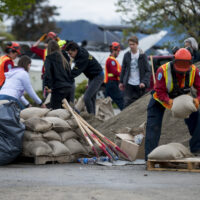Climate impacts and accelerating global climate action threaten Canada’s current and future prosperity. Examples include the devastating wildfires and catastrophic flooding in British Columbia this year and the sea change underway in global financial markets now that countries representing over 90 per cent of global GDP have committed to net zero by mid-century. To meet Canada’s emission-reduction commitments and accelerate the transition to a prosperous low-carbon future, Canada needs a whole-of-government approach capable of galvanizing action from all sectors of society.
A whole-of-government approach involves working across departments and agencies to implement a coordinated response to a complex issue or challenge. Of course, rapidly turning the entire ship of state in response to a threat is easier said than done. What follows are some considerations and recommendations that can guide the Canadian government’s efforts to implement a whole-of-government response to climate change.
Why a whole-of-government approach is needed
Climate policy, historically the purview of Environment and Climate Change Canada (ECCC), is increasingly, and necessarily, on the doorstep of many different departments—from agriculture to transport to natural resources, and from innovation to Crown-Indigenous relations and infrastructure.
Yet while more and more departments are being looped into the government’s climate agenda, they mostly continue to work in silos. The result is ineffective, and at times conflicting, policies—across and even within government departments. Departments and agencies need clearer direction and more support to work collaboratively towards common climate goals.
In other words, they need a whole-of-government approach to climate change.
We’ve fought this war before
The whole-of-government approach is not a new concept. During the Second World War, Canada established war committees and cabinets to direct sustained and coordinated emergency responses across government, successfully reorienting Canada’s entire society and economy around a new goal. And more recently, governments at home and abroad have applied whole-of-government approaches specifically to the climate crisis.
During Gordon Campbell’s 2001-2011 tenure as premier of British Columbia, the Climate Action Secretariat was an effective whole-of-government structure that helped the province adopt more ambitious targets and policies, though its influence lapsed under successive governments. Since 2019, the United Kingdom has placed a growing emphasis on whole-of-government structures and processes, including two new Cabinet committees on climate—the Climate Action Strategy Committee and the Climate Action Implementation Committee. In the United States, the Biden administration has committed to using whole-of-government approaches to support cross-government climate action. The president has used executive orders to direct procedural changes like the Executive Order on Tackling the Climate Crisis at Home and Abroad, and enact new structures—notably the new National Climate Task Force.
At the federal level in Canada, the government has already established some whole-of-government structures to advance climate policy, including a Cabinet Committee on Economy and the Environment and a climate secretariat housed in the Privy Council Office. It has also introduced external, independent advisory bodies to provide climate policy expertise to all parts of government—among them our Institute, the Canadian Climate Institute, and more recently, the Net-Zero Advisory Body.
The federal government has also implemented process changes, including using mandate letters to signal priorities and expectations around climate across departments, as well as announcing intentions to apply a climate lens throughout government decision-making. Most recently, Trudeau’s decision to move former Environment Minister Jonathan Wilkinson to head up Natural Resources Canada (NRCan) is a clear indication that experience on climate belongs beyond the environment department.
What needs to happen now
While the federal government is not starting from scratch, it’s clear that more needs to be done to embed climate considerations throughout government decision making. There was a lot of discussion leading up to the swearing-in ceremony of the new federal cabinet about just that, including the possibilities of merging ECCC and NRCan into a super climate department, or reassigning climate-related files to ECCC. But neither of those ideas has come to fruition.
Plus, as mentioned above, climate policy touches many departments, so merging a couple or shifting all responsibility to just one wouldn’t constitute a whole-of-government approach. So what can the federal government feasibly do now to create explicit cross-mandate accountabilities within government?
The federal government—specifically, the Prime Minister’s Office—could establish a new cabinet committee dedicated solely to climate change issues. It could establish smaller working groups and task forces across government departments focused on specific issues or sectors, such as a clean growth committee. It could expand the resources and role of the Privy Council Office’s climate change secretariat to give it more power and capacity to embed climate change decision making from the top down. And it could act on implementing a climate lens—which would integrate climate adaptation and mitigation considerations in all government decision making—and also expand it to include clean growth objectives.
Yet experience at home and abroad shows us that in practice, implementing a whole-of-government approach is easier said than done. And the details matter—a lot. Here’s what needs to happen to ensure success:
- First and foremost, success hinges on sustained executive leadership to set departmental priorities and incentivize inter-departmental coordination. It’s up to the Prime Minister to establish whole-of-government structures and processes and set the tone from the top down.
- Second, while executive leadership is critical, whole-of-government approaches also require buy-in from people at all levels (both on the political side and in the public service) to actually implement the approach across departments. Placing individuals with a strong commitment to climate in key posts is one way to ensure priorities from the centre are making their way throughout government decision-making.
- Third, whole-of-government structures and processes must receive sufficient resources and responsibilities. Without adequate funding or mandates, these approaches lack the capacity to enact change.
- Fourth, transparency and accountability are equally crucial, as they enable the public to know whether or not the government is following through on its commitment to prioritize climate across departments. While full transparency of government activities is unlikely (and impractical), external advisory bodies can enhance accountability by producing regular reports on progress and providing publicly available, cross-departmental advice.
Simply adding climate to every department’s checklist list won’t make for an effective whole-of-government approach. There is a real risk that without sufficient leadership, clear mandates, increased coordination, adequate resources, and enhanced accountability, a whole-of-government approach could actually result in less efficient and effective climate policy.
And as the COP26 climate summit in Glasgow underscored, governments must move quickly beyond commitment to implementation. The bottom line: implementing policies at the scale and speed needed to meet Canada’s pledges requires all government departments working together in a more collaborative, coordinated way, with clear direction from the top. Without the solid foundation of an effective whole-of-government approach, Canada’s climate ambitions rest on shaky ground.
To learn more about how Canada can establish an effective whole-of-government approach to climate change, read our new case study, published today: Greater than the sum of its parts.




